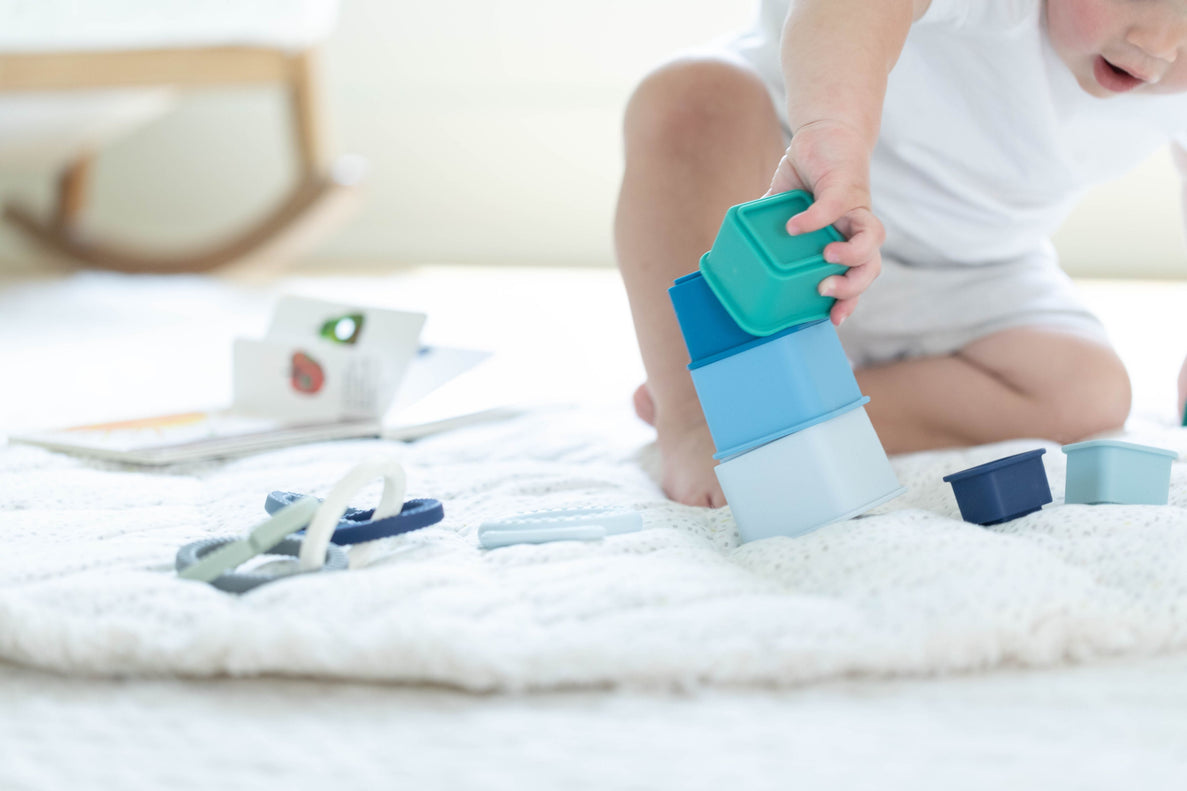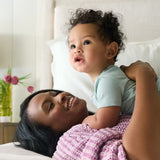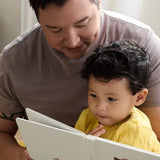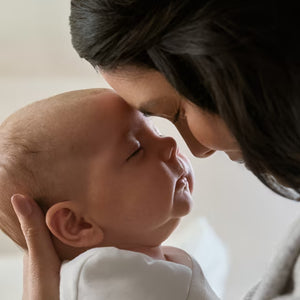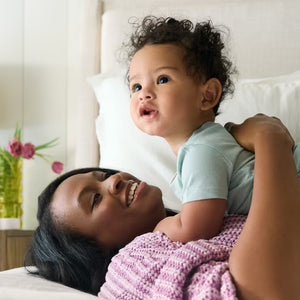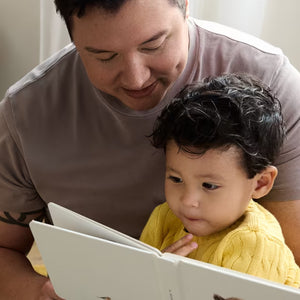Are you wondering how to play with your baby? Maybe you’re not sure what developmental activities to try? I can help! Activities for babies don’t need to be complicated. I’d love to share some of my favorite fun things to do with babies (0-18 months).
For little ones 18 months to 4 years, check out these Toddler Activities.
Did you know? How your baby spends awake time plays a role in their sleep. It’s true! Just like adults, babies sleep better when they move their bodies and use their brains during awake time. Of course, awake time isn’t the only important factor in baby sleep.
Want 5 daytime tips for better night and naps?
Activities for newborn babies:
During the newborn months, your new baby is growing quickly. You may notice your baby looking at their hands, moving their head towards familiar voices, and even starting to hold their head up for a few seconds.
When you think about activities for your newborn, you may wonder how to make time for play when feeding and diapering fills most of the wake window. Don’t worry! There’s no need to fill awake time with complicated activities. In fact, you may be surprised to learn the best toy for your newborn baby is actually YOU! Babies love that face-to-face interaction and can learn so much from you talking, holding, and staring into their sweet little face.
Here are some ideas for activities for babies during the newborn months:
Activities for a 1 month old
-
Make silly faces. Even just looking into your newborn’s eyes promotes bonding and development.
-
Talk to your baby. Not feeling creative? That’s okay! Simply narrate whatever you’re doing with your baby or around the house.
-
Add in tummy time. Even a few minutes of tummy time during each wake window adds up! The American Academy of Pediatrics recommends at least 15-30 minutes of tummy time per day (by 7 weeks of age).
Activities for a 2 month old
-
Go for a walk. Engage with your baby by telling them what you’re seeing and hearing.
-
Look at simple board books. Reading aloud and describing what you see promotes language development.
-
Sing to your baby. You don’t need to limit yourself to baby music. Sing whatever songs you enjoy listening to or play some music and dance with your baby.
If you need help setting up your newborn baby’s day, I have sample schedules for you. I also have a blog on baby play for newborns and some favorite toys for newborn babies if you need more inspiration.
Activities for Babies 3-6 Months:
You’ll probably notice big developmental changes during months 3-6. Your little one may start rolling, babbling, and sitting with support. They’re also able to stay awake a bit longer between naps and before bed. This means that your baby is likely going to transition from 4 naps to 3 during these months. Adding in some activities during awake time can help with stretching wake windows and dropping a nap.
The best activities at this age are the ones that allow your baby to explore the world around them! Here are some fun things to do with babies during months 3-6:
Activities for a 3 month old
-
Use a playmat or play gym to encourage movement, like reaching and rolling.
-
While you’re sitting on the floor in front of a couch, lay your baby with their tummy on the couch cushion facing you. This allows time to practice lifting their head to see and interact with you. (Be sure that you are right there with them the whole time!)
-
Sing songs with motions like “Itsy, Bitsy Spider,” “Head, Shoulders, Knees, and Toes,” and “Wheels on the Bus.” Help move your baby’s arms to make the motions while you are singing.
-
Encourage your baby to explore their hands or feet by tickling them or clapping them together.
-
Play around with tracking objects. Move objects slowly across your baby’s field of vision (about 10 inches away from them) to allow them to track the movement with their eyes. Your baby may even begin to bat at the object soon!
Here are ideas for the best toys for 3 month olds.
Activities for a 4 month old
-
Talk and sing with your baby throughout their awake time. You can find fun songs for babies or just talk through what you’re doing that day. We want your baby exposed to language!
-
Use a playmat or play gym for tummy time and rolling practice. (Playmats are also great for promoting independent play.)
-
Give your baby toys that are safe for little mouths. Things like rattles, teethers, and other infant toys are great options to practice grasping and exploring with their mouth.
-
Give your baby crinkle books with high-contrast colors and patterns.
-
Offer your baby rattles or things that make noise when your baby shakes them in their hands. (They might not shake them purposefully yet, but it will still be fun!)
-
Use a mirror to look in and make faces with your baby.
Here are ideas for the best toys for 4 month olds.
Activities for a 5 month old
-
Talk a walk and narrate the walk – What do you see? What do you hear? Have fun exploring outside. Let your little one touch the grass with their toes.
-
Have a pacifier lover? Try the Binky Game to help them learn to replace their pacifier on their own.
-
Have lots of floor time to help encourage rolling and sitting upright while supported. Position toys around your baby instead of directly in front of them to encourage movement.
-
Give your little one a small bin with random (non-choking hazard) objects: tennis ball, cup, bells, ribbon, etc.
-
Play peek-a-boo! Use your hands, a scarf, or hide behind something and pop out.
-
When your baby makes sounds like “ba” or “da” copy them and see if your baby starts to repeat them. (Be sure to pause as if you are having a conversation with your baby.)
Here are ideas for the best toys for 5 month olds.
These are suggestions for activities for babies 3-6 months. Keep in mind, every baby develops at their own pace. You can try these activities before, throughout, and after these months. Your baby will continue to learn and explore their world with the same activities even at different ages. If you need help setting up your baby’s day, I have sample schedules for you.
Activities for Babies 6-12 Months:
You may notice that your baby is showing signs of increased mobility, communication, and awareness of the world around them. Your baby may be crawling, sitting up unassisted, and using gestures. Many babies this age love putting objects in and out of a container, stacking objects, and reaching to grab toys. Your baby is also going to transition from 3 naps to 2 during these months.
You can help your baby get active awake time and stretch their wake windows by trying some of these activities for babies 6-12 months old:
Activities for a 6 month old
-
Give your baby a container with objects (toys, cups, blocks) so they can practice putting them in and taking them out.
-
Play a game having your baby transfer objects between hands. If your baby doesn’t do this on their own, try to offer a second object to the same hand and see what happens!
-
Have your baby sit up (with assistance if needed) in front of a mirror to look at themselves and you.
-
Engage with toys with lights and sounds.
-
Allow your baby to explore teething toys with lots of textures.
-
During tummy time, offer a toy that encourages them to push up on both hands or reach. Things like a wobble toy, ball, touch and feel book, or a Montessori spinning drum can be really fun for this age.
Here are ideas for the best toys for 6 month olds.
Activities for a 7 month old
-
Place fabric, ribbons, and other objects in a tissue box, shoe box, or empty wipe container for your baby to pull out and stuff back in.
-
Try out some blocks. Simply let your little one explore with them. This also encourages movement as your baby is rolling and wobbling.
-
Practice crawling skills by placing a toy just out of reach. Try an exciting toy to motivate them to start moving.
-
Let your baby explore stacking cups. Even if they simply knock them over after you stack them, it can be fun for them!
-
Take a little walk around the block describing what you see and allow your baby to interact with nature (Think touching the grass, smelling the flowers, or pointing at birds.)
Here are ideas for the best toys for 7 month olds.
Activities for an 8 month old
-
Practice pulling up and standing while supported. Some ways to practice are: your baby pulling up holding onto your arms, holding onto a stable piece of furniture while supervised, or an activity center. (Keep in mind that it’s recommended that activity centers or “containers” should be used for 15 minutes or less per day.)
-
Explore different textures around the house, like soft blankets or a brush.
-
Engage in sensory play using food like O’s cereal and yogurt.
-
Play with a water table, which helps encourage pulling up and standing. (Safety Tip: Please be sure to closely supervise your little one with any water-related activity.)
-
Use touch and feel books to explore textures, pictures, and words.
-
Practice waving in the mirror or go outside and wave at people and cars passing by to help your baby learn “Hi” and “Bye.”
Here are ideas for the best toys for 8 month olds.
Activities for a 9 month old
-
Play peekaboo games to help learn object permanence.
-
Give them lots of practice with standing up and plopping down on their bum with an activity center or stable furniture.
-
Have a ball pit for fun grabbing balls and practicing sitting on their own.
-
Build a small tower and allow your baby to knock over the blocks to see where they fall. They may even try to crawl or pull themselves toward the tumbled blocks.
-
Read books together. Try some books with faces to help your baby learn facial expressions.
-
Let your baby flip light switches on and off in different rooms or turn the sink faucet on and off to play in the water. (Safety Tip: Please be sure to closely supervise your little one with any water-related activity.)
Here are ideas for the best toys for 9 month olds.
Activities for a 10 month old
-
Promote mobility for your 10 month old by:
-
Encouraging crawling through a play tunnel.
-
Rolling balls and allowing your baby to crawl after them.
-
Practicing pulling up on furniture.
-
-
Make music together! Interactive songs like “Itsy, Bitsy Spider” and “Wheels on the Bus” are also entertaining for your baby. Add in some musical instruments for extra fun.
-
Take a tour of your home and practice naming different objects you see.
-
Get outside! Observe your baby to see if they are turning towards any hidden sounds, like a dog or bird, and talk about that sound, “Hear the dog say ‘woof’?”
-
Try filling shallow storage bins with different textured materials like oats or ground up O’s cereal for sensory play. Do this in the tub or outside if you’re mess-averse. (Please be sure to closely supervise your baby with this activity.)
Here are ideas for the best toys for 10 month olds.
Activities for an 11 month old
-
Encourage mobility by supervising your baby cruising along the sofa.
-
Try an activity walker to get your baby moving as they practice standing up and pushing it along.
-
Promote hand-eye coordination by rolling a ball back and forth with your baby.
-
Build on your baby’s understanding of object permanence by hiding objects under small boxes or containers (or consider some toys that allow your baby to practice this concept).
-
Offer toys that allow your baby to imitate you like a toy phone.
-
Create a safe space in the kitchen for your baby to explore, like a bottom drawer with plastic containers and measuring cups.
-
Turn on the music and have a dance party! Let your baby make music by drumming on a bowl with a spoon (This helps with hand-eye coordination too.).
Here are ideas for the best toys for 11 month olds.
These are suggestions for activities for babies 6-12 months. Keep in mind, every baby develops at their own pace. You can try these activities before, throughout, and after these months. Your baby will continue to learn and explore their world with the same activities even at different ages. If you need help setting up your baby’s day, I have sample schedules for you.
Activities for Babies 12-18 Months:
Major developmental strides can happen during months 12-18. Your little one is cruising around, and their personality is really shining. They’re also showing emotional growth (cue the tantrums!), and their language is budding. Your 12-18 month old loves watching everything you do. Including them in safe, easy activities with you around the house is a great way to spend awake time together. You’re probably noticing your baby is able to stay awake longer during the day. Typically, little ones are ready to transition from 2 naps to 1 between 13-18 months.
Wondering how to fill their awake time or help stretch their wake windows?
Here are some ideas for developmental activities for 12-18 month olds:
Activities for a 12 month old
-
Try stacking activities with objects around the house or a block set. Stacking helps build cognitive and fine motor skills.
-
Explore sensory play together. Make taste-safe play dough together, dump a cup of O’s cereal into a small bin and add some spoons and scoops, or simply fill up the bath and let your little one play. (Safety Tip: Please be sure to closely supervise your little one with any water-related activity.)
-
Little ones at this age love zippers, strings, buttons, and snaps. Play with a busy board. Don’t have a busy board? Try letting your little one flip the light switch on and off.
-
Encourage some role-play with toys or household items that allow your baby to mimic everyday life (They love this!). Things like a toy stethoscope, a hairbrush to brush their doll’s hair, measuring cups to “make recipes,” or a small broom to "help with cleaning."
Here are ideas for the best toys for 12 month olds.
Activities for a 13 month old
-
Get outside! Try a park for some swinging and exploring.
-
Encourage language development through reading and singing to your baby. Lift-a-Flap books are fun for curious little ones!
-
Blow bubbles! If it’s a cold or rainy day, you can even try blowing bubbles in the bath. (Safety Tip: Please be sure to closely supervise your little one with any water-related activity.)
-
See if your baby can “help” you find favorite toys. Place familiar toys around the room and ask your baby to show or bring them to you (“Where’s the ball?”).
-
Engage your baby’s senses with some sensory play. Wrap some objects (like toy animals or small blocks) in tissue paper and let your baby unwrap them. It’s a 2-for-1! They can play with the object inside or may find the paper even more exciting.
Here are ideas for the best toys for 13 month olds.
Activities for a 14 month old
-
Encourage your little artist with some large crayons and paper or finger painting. If you’re not a fan of messy activities, try using water to “paint” on construction paper. There are also some great mess-free options you can buy.
-
Promote social skills by playing with stuffed animals. Have familiar accessories like a bottle, tissue, blanket, or wipes to allow them to play out their day with a doll. (Bonus: If your baby is sick and needs medicine, it can help to let them offer a syringe to their baby doll before you give them the medicine.)
-
Create a little photo album- think pictures of family members, animals, or even colors. You can DIY or use a photo album website. This is a great way to engage with your baby and help with language development!
-
Build an obstacle course using soft objects, like pillows or cushions. Add in some soft balls to entice your little one to try rolling, throwing, and chasing.
Here are ideas for the best toys for 14 month olds.
Activities for a 15 month old
-
Create a DIY object permanence toy by making holes in a shoebox that your child can push cotton swabs or playing cards through. (DIY not your thing? That's okay! There are some great pre-made options available that I linked below.)
-
Help refine motor skills and coordination by stacking (Try things around the house like upside down measuring cups.).
-
Try sensory play with water. (This is a great way to add time to a wake window.) Set up a shallow storage bin with a little water and measuring cups.). (Safety Tip: Please be sure to closely supervise your little one with any water-related activity.)
-
Encourage social skills through role play. This is so fun for little ones this age! Try a mini spray bottle and cloth for “cleaning” the house or “bake” muffins by putting pom poms in a muffin tin.
Here are ideas for the best toys for 15 month olds.
Activities for a 16 month old
-
Practice throwing or rolling a soft ball. You can make this a sensory activity by making balls out of tissue paper and tossing them in a laundry basket. Your little one might also like to get in the basket like a ball pit!
-
Invite them to help you with laundry. Show them how to put clothes in the dryer and give them the opportunity to imitate you. You may be surprised how exciting laundry can be for your toddler!
-
Build a fort! Set up some chairs and throw a big blanket over them. Read together in the fort, use a flashlight, or bring some toys in!
-
Try some pretend play! Set up a little tea party or “cook” together using items from the kitchen
Here are ideas for the best toys for 16 month olds.
Activities for a 17 month old
-
Build a house (boat, train, rocket or whatever you want to imagine) out of a large box. Your toddler will enjoy going in and out and exploring. Bonus activity: allow your little one to decorate! You can use markers or paint. Or if you want to minimize mess- try stickers or tape to put pictures on the box.
-
Invite your toddler to help you with everyday tasks. They love imitation! This could look like adding diapers to the diaper bag or helping to feed a pet.
-
Go on a walk! Explore nature together. Even a little walk around the neighborhood is exciting at this age. Give your toddler a bucket to collect leaves, sticks, or anything else they might find.
-
Get in the tub! Add in some entertaining bath toys or large pom poms to extend play time. (Safety Tip: Please be sure to closely supervise your little one with any water-related activity.)
Here are ideas for the best toys for 17 month olds.
Activities for an 18 month old
-
Sing songs that help your little one identify body parts, like “Head, Shoulders, Knees, and Toes” or “The Hokey Pokey.”
-
Engage in sensory play with “taste-safe” play dough. Keep it simple! Demonstrate rolling, poking, and squishing. Enhance fine motor skills by sticking straws in the play dough or through holes in a shoebox.
-
Put sticky notes on a wall and let your toddler pull them off. Show them how to stick them back up, and play again!
-
Dig for buried treasure! Fill a shallow bin with oats and hide small objects like pom poms or puzzle pieces and let your little one explore with their hands or scoops. (Safety Tip: Please be sure to closely supervise your little one with any small objects.)
Here are ideas for the best toys for 18 month olds.
Safety Tip: During months 12-18, your toddler is wanting more independence, but still needs close supervision, especially as they are becoming more mobile. It’s a good idea to check around your house for any new safety concerns (think areas that your toddler may not have been able to reach or open before). Be sure furniture is anchored and door knobs are child proofed. You can find my [favorite baby proofing products](baby proofing products) here.
These are suggestions for activities for babies 12-18 months. Keep in mind, every baby develops at their own pace. You can try these activities before, throughout, and after these months. Your baby will continue to learn and explore their world with the same activities even at a different ages. If you need help setting up your baby’s day, I have sample schedules for you.

